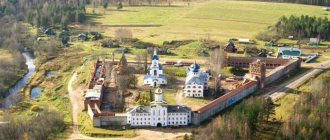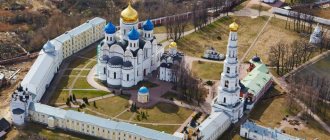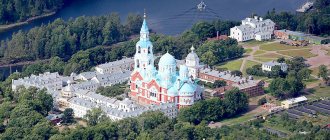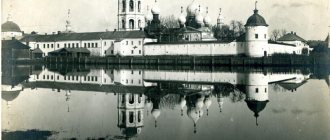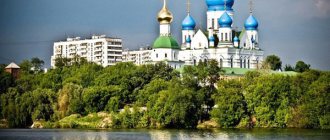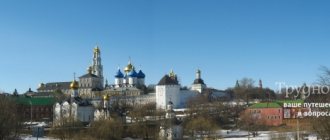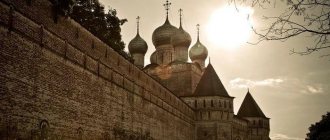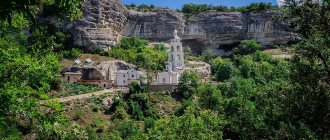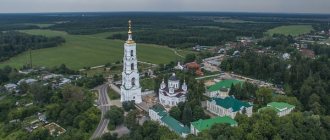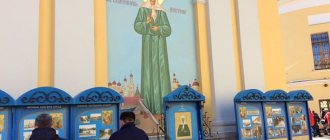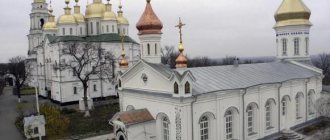| Nikolo-Ugreshsky Monastery |
Ugreshsky Men's Monastery in the name of St. Nicholas the Wonderworker
, stauropegy of the Russian Orthodox Church within the boundaries of the Podolsk diocese
- Address: Russia, 140056, Moscow region, Dzerzhinsky, pl. St. Nikolay, 1
- Tel.
- Official site:
- Directions from Moscow: from metro station Kotelniki avt. 470, 347; from metro station Lyublino avt. 305; from metro station Alma-Ata highway. 1063; from metro station Bratislavskaya march. 1207k; from Kazansky railway station to square. Lyubertsy, further aut. 20, 21 to the stop. St. Nicholas Square.
- On the map: Yandex.Map, Google map
| The appearance of the icon of St. St. Nicholas the Wonderworker led book Dimitry Donskoy. Icon |
The history of the monastery is connected with the Battle of Kulikovo (September 8, 1380). The gathering of the Russian army under the leadership of Grand Duke Dmitry Donskoy was appointed in Kolomna. From here the army was supposed to advance to battle with the Tatar Khan Mamai. 15 versts from Moscow on the road to Kolomna, the Grand Duke and his army stopped to rest. Here, on a pine tree, in a radiance, the image of St. Nicholas the Wonderworker appeared to him. Through the prayer of the prince, the boyars and the army, the icon itself descended into the hands of Demetrius. According to legend, the prince exclaimed: “ This whole sin has sinned my heart
.” Since then, the place where the miraculous icon appeared was called Ugresha [1]. On August 9, 1380, the Grand Duke ordered the founding of a monastery here in the name of St. Nicholas in gratitude to God for the victory over the Mongols. The monastery is located near the palace village of Ostrov. Due to the proximity of the monastery to the “amusing” village (as the palace village was called because it served as a place for entertaining royalty with hunting), the sovereigns often visited the monastery. This connection with the ruling house was expressed in the fact that already in the century the courtyard of the Nikolo-Ugreshsky Monastery was opened in the Moscow Kremlin. The Grand Duke of Moscow Vasily the Dark donated to the monastery the villages of Kapotnya and Zhiroshkino in the Moscow district. In 1521, the Nikolo-Ugreshsky Monastery was burned down during a raid by the Crimean Khan Makhmet-Girey, but was soon rebuilt. In 1545, Tsar Ivan IV Vasilyevich granted the monastery a charter, which secured the monastery’s right of ownership of fourteen villages in four districts, and prohibited anyone from traveling to the monastery’s forests and groves and cutting them down. In 1567, with his letter of grant, he confirmed the monastery’s right to own fishing grounds in Nizhny Novgorod. From the same charter it is clear that the Ugresh monastery was exempt from customs duties on all monastic goods throughout the state, except for Nizhny Novgorod - this position was confirmed by subsequent kings.
In 1610, the impostor Tsar False Dmitry II stayed for some time in the Nikolo-Ugreshsky Monastery. In the spring of 1611, the monastery became one of the gathering places for Russian troops, who responded to the call of Patriarch Ermogen to defend Russia from Polish invaders. The following year, the monastery's courtyard in the Moscow Kremlin was destroyed during its siege.
The monastery was the site of the so-called “Ugresh campaigns” - pilgrimages of sovereigns to the Nikolo-Ugreshsky monastery. In 1519, Grand Duke Vasily III Ivanovich visited the Nikolo-Ugreshsky Monastery [2]. Mikhail Feodorovich officially visited the monastery nine times, Alexei Mikhailovich thirteen times, and the young Tsar Peter visited the Nikolo-Ugreshsky Monastery three times. In 1639, the courtyard of the Nikolo-Ugreshsky Monastery in the Moscow Kremlin was restored. By the middle of the century the monastery had reached the zenith of its glory. In 1668, three patriarchs visited the monastery with Tsar Alexei Mikhailovich: Paisius of Alexandria, Macarius of Antioch and Joasaph of Moscow, as well as a numerous host of bishops and other clergy. At the crowning of Theodore Alekseevich in 1676, the Ugresh abbot presented the scepter to the patriarch, and at the wedding of Ivan V Alekseevich in 1682, the barma of Tsar Ivan, which indicates the high position of the monastery at that time.
Decline of the monastery
The 18th century was a century of difficult trials that befell the Orthodox Church. Peter I, heading to the West, opened a “window to Europe.” Russia was far behind Europe in technical development, and for the security of the state it was necessary to develop industry, science, and military affairs. However, along with the development of industry, the spiritual life of the state declined. Secularization took place, i.e. secularization of society. The Nikolo-Ugreshskaya monastery was no longer of interest to the royals and began to fall into decay. Secular authorities did not allow new monks to enter the monastery, and donations were sharply reduced. The number of brethren decreased, the buildings fell into disrepair, and the Synod did not release funds for their repair.
Only in 1742, after a severe storm, did the Synod release funds for the renovation of buildings. Since some buildings had already collapsed over the years, as a result, many stone buildings were dismantled and replaced with wooden ones.
In the second half of the century, construction picked up somewhat - a bell tower and a stone Assumption Church were built. At the same time, the secular authorities used the monastery as a colony-sanatorium - in 1763, retired soldiers who received salaries from the monastery were placed here; in 1771, an infirmary for the plague was established, and therefore the brethren were temporarily transferred to the neighboring Nikolo-Perervinsky monastery. During the secularization reform of Catherine II in 1764, according to the new monastic states, the monastery was classified as a regular third-class monastery.
In 1771, the monastery's courtyard in the Moscow Kremlin was abolished.
In 1795, the miraculous icon of the Mother of God “Leaping” was found in the monastery - an omen of the revival of the monastery. In 1812, the monastery was occupied by the French, but the monastery sacristy was not damaged, as it was taken to Vologda in advance.
In the first half of the 19th century, the monastery became the place of service of St. Innocent (Smirnov), St. Ignatius (Brianchaninov) was appointed here, who subsequently took part in the life of the monastery, St. Philaret of Moscow, as the diocesan bishop, paid a lot of attention to the monastery. In 1833, when only six monks remained, they intended to close the monastery. But thanks to the patience and diligence of Abbot Ilarius and his successor, Rev. Archimandrite Pimen (Myasnikov), the spiritual foundation for future prosperity was laid. On October 16, 1853, a communal charter was introduced in the monastery.
New blossoming of the monastery
| Nikolo-Ugreshsky Monastery. Engraving 2nd floor. XIX century |
Already in the 1840s, the construction of new and restoration of old churches of the monastery began.
With the generous donations of philanthropist Pyotr Matveevich Alexandrov, construction work is underway. In the second half of the 19th century, a grandiose architectural ensemble was created in the monastery; F. G. Solntsev became the main artist and architect. The significantly expanded territory was surrounded by a new stone wall 1700 m long and 5–6.5 m high, with 16 towers and 8 gates. In the decorative design of the northern (“Palestinian” or “Jerusalem”) wall, completed in 1866, a traditional image of Jerusalem was used in Russian icon painting, so that those approaching the monastery from Moscow would see a panorama of the Holy City in front of them. By 1860, a monastery was built next to the monastery. Contributions were made to the monastery again - in 1859, a house on Taganka, in 1863, a dacha in the Ruza district of the Moscow province (136 dessiatines), in 1870 a dacha in the Aleksandrovsky district of the Vladimir province. Since August 24, 1858, the abbot of the monastery held the rank of archimandrite. In 1866, a third-grade school for peasant children was opened at the monastery, which in 1876 was transferred to the jurisdiction of the Ministry of Public Education. In 1870, the Holy Synod gave permission to increase the staff of the monastery from 12 to 92 people. At this time the monastery had more than a hundred inhabitants. In connection with the celebration of the 500th anniversary of the monastery, the majestic Transfiguration Cathedral was founded, which became the architectural center of the monastery. In 1913, 19 versts northwest of the Holy Trinity Lavra of St. Sergius, in the forest in the possession of the Nikolo-Ugreshsky Monastery, monks seeking desert living built cell houses and a church in the name of the newly glorified Saint Hermogenes, Patriarch of Moscow. In 1915-1916, the future martyr Ermogen (Dolganev) lived in the monastery.
Abolition and destruction under Soviet rule
The first legislative actions of the Bolshevik government deprived the monastery of real estate and a parochial school. From mid-1918, local authorities began partial confiscation of church valuables, economic and residential buildings and equipment of the Nikolo-Ugreshsky Monastery for the establishment of a children's colony and a Narkomfin rest house. Famine began and the brethren began to leave the monastery, as evidenced by Saint Macarius (Nevsky), who was in retirement here. Despite the protests of the peasants, the authorities plunder the monastery and humiliate the metropolitan and archimandrite who live here.
In 1919, in order to preserve the monastery and economic holdings, the brethren were organized into a labor artel, which received the name Nikolo-Ugreshsky labor community. In 1922, a campaign began to confiscate monastery valuables, which the Ugresh Archimandrite resisted to the best of his ability. In 1924, the transfer of monastery property to the Moscow Soviet began. The monastery is populated by children and adults under the auspices of the Moscow Department of Public Education, the property is redistributed and part goes to representatives of the Main Science Department as “museum property.” In 1925, a miraculous renewal of the icon of St. Nicholas took place, which was hastily confiscated by the authorities. Due to numerous interdepartmental contradictions, the eviction of monks lasts about two years.
In the end, the monastery was finally taken away from the Church. Its buildings housed a children's colony, a canteen, a factory kitchen, a factory workshop, a school, a hotel and other institutions. In January 1929, the Hermogen Hermitage also closed. The process of desecration and destruction of shrines is underway. In 1940, the oldest and main temple of the monastery, St. Nicholas Cathedral, was destroyed.
Since the 1950s, the authorities began to make attempts to preserve the remains of the monastery ensemble. Since 1970, restoration work has been carried out. Until the end of the century, six churches with 10 altars and a chapel survived.
| Pimenovsky Church of the Nikolo-Ugreshsky Monastery. Photo by Vladislav (strusto) January 8, 2008 |
Renaissance
In 1990, an initiative group was created in the city of Dzerzhinsky to resume worship in the Nikolo-Ugreshsky Monastery, and at the end of the year the city Council of People's Deputies decided to transfer to the Church the premises of the Assumption Church of the former Nikolo-Ugreshsky Monastery. At the end of 1990, the first divine services were again performed by Archimandrite Veniamin (Zaritsky). On January 30, 1991, the Moscow Regional Council decided to return the monastery to the Russian Orthodox Church. The Nikolo-Ugreshsky Monastery received the status of stauropegial.
Despite the restoration that had once been carried out, the monastery was in dire condition. Temple buildings, neglected, decapitated, disfigured by numerous reconstructions; ruins overgrown with weeds and neglected ponds. But there were many benefactors in the city, from the mayor to many ordinary townspeople who wished to take part in the restoration of the monastery. Intensive restoration began. On May 1, 1991, Patriarch Alexy II visited the monastery and consecrated the Assumption Church - the first church opened in the monastery after decades of neglect. The Patriarch, as the holy archimandrite of the monastery, continued to show it special attention, coming to the consecration of the revived churches. From the first days of the opening of the monastery, the tradition of bell ringing was revived in the monastery. In 1993, through the efforts of the brethren, a temple was opened in the hospital in the city of Dzerzhinsky in the name of the great martyr and healer Panteleimon. One by one, churches were restored, and new ones appeared, such as the Pimenovskaya and Passion Churches.
In 1993, NPO Soyuz handed over a “green workshop” with greenhouses, a garden and various buildings to the monastery. An exemplary farm was organized here. In 1992, a Sunday school was opened in the monastery, and in 1998 - a theological school, transformed in 1999 into a theological seminary. The library and publishing house started working. The brethren of the monastery took patronage over the Moscow Higher Combined Arms Command School.
On April 27, 2021, by decree of Patriarch Kirill of Moscow and All Rus', the monastery was provided to the Patriarchal Vicar of the Moscow Metropolis for the residence of the administration of the metropolis, Metropolitan of Krutitsky and Kolomna Pavel (Ponomarev) and the establishment in it of the diocesan administration of the Kolomna diocese [3])
Statistics
- 1655 [4] - more than 50 Ugresh monks died from the plague.
- 1833 - 6 monks.
- 1875 [4] - 130 monastics and Balti people; 11 thrones.
- 1909 [4] - 154 inhabitants (21 hieromonks, 10 hierodeacons, 23 monks, 100 novices).
- 1914 [4] - 64 monks (2 archimandrites, 20 hieromonks, 10 hierodeacons, 19 monks, 12 Balti)
- 1916 - [4] 59 monks, many of the novices are listed as being taken to the front.
- 1917 - 10 churches with 18 altars; 5 chapels.
- 1923 - 45 people in the monastic labor artel.
- 2000 - [4] inhabitants 33 people (12 hieromonks, 6 monks, 14 novices)
- 2004 - [4] more than 30 monks.
| Transfiguration (back) and St. Nicholas (foreground) cathedrals of the Nikolo-Ugreshsky Monastery. Photo, spring 2007 |
Temples, architecture
Transfiguration Cathedral
The Cathedral in honor of the Transfiguration of the Lord was built in 1880-1894 by architects A. S. Kaminsky and B. V. Freidenberg. Money for construction (about 400,000 rubles) was donated by Vladimir Vasilyevich Pegov. Consecration followed on July 24, 1894. The interior painting was done by icon painter M. N. Safonov based on drawings by A. S. Kaminsky. He also painted icons for the five-tier handmade iconostasis, made by carving artist V. A. Astafiev. The interior spaces of the cathedral were so huge that six gilded bronze chandeliers were used to illuminate them. The cathedral became the center of the new monastery ensemble. The height of the cathedral church from the ground to the top of the cross reaches 77 meters. Chapels were built in it in the name of Equal-to-the-Apostles Grand Duke Vladimir (right) and Grand Duchess Olga (left). After being abandoned under the godless regime, the cathedral was restored in 1992 and re-consecrated on May 28, 2000. In the post-Soviet period, the revived cathedral, now designed for 7,000 worshipers, became the second largest church in the Moscow region after the Cathedral of Christ the Savior. The revived cathedral has a large five-tiered iconostasis 24 meters high and 25 meters wide, the icons of which were painted by Palekh masters.
| Sorrowful Hospital Church of the Nikolo-Ugreshsky Monastery |
St. Nicholas Cathedral
The oldest church in the monastery was dedicated to St. Nicholas the Wonderworker. In the 16th century it was rebuilt again, and in 1614 it was updated. In 1840, the next restoration of the St. Nicholas Cathedral Church of the monastery began according to the plan of the provincial architect D. F. Borisov. The funds were donated by the pious elder Avdotya Ivanovna Rybnikova. In 1843, the reconstruction was completed and the iconostasis was gilded.
The temple was destroyed in 1940. Restoration work began in December 2003 and by 2007 the temple was already completed. It is located on the Cathedral Square of the monastery a few meters from the Transfiguration Cathedral.
Sorrowful Temple
Church of the Icon of the Mother of God “Joy of All Who Sorrow” at the monastery hospital in the center of the eastern wall of the monastery. The church was built by architects A. S. Kaminsky and M. D. Bykovsky, with donations from patrons of the arts Alexandrovs. Construction began in 1857, was completed by July 1860, and was dedicated on July 24 of the same year. It was closed in the 1920s. The wedding is broken. Renovated in 1999 and re-consecrated on November 16 of the same year. Nowadays it is a fraternal temple.
Pimenovsky Temple
The temple in the name of St. Pimen of Ugreshsky was built with the assistance of the Main Directorate for the Execution of Punishments of the Ministry of Justice of the Russian Federation, in memory of the fallen employees of the Ministry. The church was built in the style of Vladimir-Suzdal temple architecture of the 12th century, modeled on the Church of the Intercession on the Nerl. Construction began in 2001, and on September 22, 2002, the temple was consecrated by Patriarch Alexy II of Moscow and All Rus'.
| Kazan Church of the Nikolo-Ugreshsky Monastery. To the left is an almshouse, to the right is a fraternal building. |
Kazan Temple
A warm church in honor of the Kazan Icon of the Mother of God was built at the almshouse and consecrated in 1870. The church was built through the zeal of the Moscow honorary citizen Rogatkin. In 1875, near Kazan, a warm church was consecrated in the name of St. Vasily, confessor, Bishop of Paria, built at the expense of the Moscow merchant Vasily Lukich Vasiliev. After being abandoned during the Soviet period, they were restored in the first half of the 2000s.
Assumption Church
The temple in honor of the Dormition of the Blessed Virgin Mary was erected in 1763 and restored in 1851. It has a chapel in the name of St. Mary of Egypt. This church became the first newly consecrated temple of the monastery after the desolation of the Soviet period - it was consecrated by Patriarch of Moscow and All Rus' Alexy II on May 1, 1991. On April 13, 1997, the chapel of St. Mary of Egypt was re-consecrated.
Matthew-Paraskevinsky refectory church
The temple at the fraternal meal was consecrated in 1853 in the name of the Apostle Matthew and the Great Martyr Paraskeva. The temple was built through the zeal of the Alexandrovs' benefactors in memory of their parents. After being abandoned during the Soviet era, it became operational again in 1994.
| Bell tower of the Nikolo-Ugreshsky Monastery. In the foreground is the memorial St. Nicholas Chapel |
Bell tower and St. John's Church
In 1758, construction began on a three-tiered monastery bell tower designed by architect I. Zherebtsov. The bell tower was completed after 1778.
The temple in honor of the Beheading of John the Baptist was built under the bell tower in a tent in 1840 at the expense of the Moscow merchant I. P. Pyatnitsky [5].
In 1859, the Baptist Church was rebuilt in connection with the addition of 4 tiers of the bell tower, which became the dominant feature of the monastery architectural ensemble. There were 18 bells in the bell tower. After partial destruction during the Soviet period, the bell tower was restored in 2003 and again reached a height of more than 90 meters.
St. Nicholas Chapel
In 1754-1755, a chapel was built in the name of St. Nicholas the Wonderworker at the holy gates. It was renewed in 1855 in connection with the construction of walls.
Subsequently, another chapel of the same dedication was built - on the site where the pine tree stood, on which the icon of St. Nicholas the Wonderworker was revealed to Grand Duke Demetrius Donskoy. The architect was A. S. Kaminsky, and the consecration followed on September 19, 1893. The funds were donated by Osinova and other pilgrims. After destruction during the Soviet period, the chapel was restored and consecrated on May 22, 1998.
Sergius Church in the Bishop's Chambers
In 1870, the cross church in the name of St. Sergius of Radonezh was consecrated in the Bishop's Chambers, with a bell tower. The temple was built from materials that were purchased in the village of Ostrov.
| Peter and Paul Church and the Vzyskan Chapel of the Nikolo-Ugreshsky Monastery. Photo by Vladislav (strusto) January 8, 2008 |
Peter and Paul Skete Church
In the monastery monastery there is a temple in the name of the apostles Peter and Paul. It was founded on October 18, 1859 at the expense of Pyotr Ivanovich Kumanin. On September 15, 1860, Saint Philaret consecrated the temple. After being abandoned during Soviet times, it was re-consecrated on June 23, 1995.
Chapel "Recovery of the Lost"
The chapel in honor of the icon of the Mother of God “Seeking the Lost” near the middle pond was completed in 2001.
Passionate Temple-Chapel
The temple-chapel in honor of the Passion of the Lord was completed in 2004.
Lost temples and chapels of the monastery
Temple of the Savior Not Made by Hands
There is a mention of a temple in honor of the image of the Savior Not Made by Hands, in which there is no service due to its disrepair, under the year 1750. Services were again declared suspended in 1757 due to the danger of the building collapsing.
Spiritual Church
The church in honor of the Descent of the Holy Spirit on the Apostles was consecrated at the monastery school in 1871 or 1873. The church had a wooden painted iconostasis with gilded outlines and icons of the Friarsian script without frames. Instead of a chandelier there hung a large bronze chandelier. At the temple there was a bell tower with a special ringing of bells.
Cross Sign Chapel
In 1868, with private contributions from pilgrims, a wooden chapel was built at the brotherly cemetery in honor of the Sign of the Cross in Heaven. On the ceiling, made of different types of wood, was a carved image of the Holy City of Jerusalem.
Schedule of services at the Nikolo-Ugreshsky Monastery
The holy monastery is currently active. Services in the Nikolo-Ugreshsky Monastery are held daily. The schedule of the Nikolo-Ugreshsky Monastery is published for the current week. It indicates not only the time and type of service, but also current church holidays.
The time of worship in the Nikolo-Ugreshsky Monastery differs depending on the day of the week. On weekdays, 2 liturgies are served:
- The early one takes place in the Assumption Church at 06:45. Afterwards there is a memorial service.
- The late one takes place at 09:00: in the summer in the Pimenovsky Church; in winter - in the Kazan Church. After the late liturgy, a prayer service is held at the Nikolo-Ugreshsky Monastery.
Service in the monastery, © Nikolo-Ugreshsky Monastery vkontakte
On weekends and church holidays, 3 divine liturgies are held:
- 06:30 - Assumption Church.
- 08:00 - Pimenovsky Church.
- 09:30 - Transfiguration Cathedral.
On weekends, after the latest liturgy, a water prayer service is held. The blessing of water is carried out on Fridays, in the Church of the Apostles Peter and Paul.
Schedule of services in the Nikolo-Ugreshsky Monastery (official website)
Abbots and governors
- Jonah (mentioned 1432 - mentioned 1443)
- Abraham (? - 1490/1491)
- Silouan the Greek (? - 1493)
- Neil the Greek (between 1494 and 1506)
- Tikhon (1517 - 1520)
- Tikhon (Khvorostinin) (mentioned 1572 - 1573)
- Lawrence (mentioned 1589)
- Eleazar and Tikhon (mentioned February 17, 1598) [6]
- Jonah (mentioned 1610) [7]
- Dionysius (mentioned September 28, 1645)
- Vincent (? - 1672)
- Gerasim (mentioned 1676)
- Joseph/Joasaph (mentioned 1682) (possibly this is Archbishop Joseph of Arkhangelsk)
- Triphylliy (Inichov) (1691 - 1692)
- Varlaam (mentioned 1737)
- Feofan (Charnutsky) (1744)
- Iriney (Bratanovsky) (1759 - 1762)
- Jerome (Ershov) (XVIII century)
- Lavrenty (Bakshevsky) (January 25, 1808 - ?)
- Evgeny (Kazantsev) (July 5 - August 6, 1810)
- St. Innokenty (Smirnov) (August 6 - October 14, 1810)
- Plato (Berezin) (1821 - 1822)
- St. Ignatius (Brianchaninov) (1833)
- Ilarius (1834 - 1851)
- St. Pimen (Myasnikov) (November 16, 1851 - October 16, 1853) acting
- Vassian (Smirnov) (August 18 - November 20, 1880) acting
1920s - 1990 - closed and ruined
- Veniamin (Zaritsky) ((December 11, 1990) June 12, 1992 - May 31, 2010)
- Bartholomew (Petrov) (June - December 24, 2010) acting
Shrines
- relics of the Ugresh Archimandrite St. Pimen (Myasnikova) - in the Transfiguration Cathedral,
- Tikhvin Icon of the Mother of God - given to the monastery by Patriarch of Moscow and All Rus' Alexy II - in the Assumption Cathedral of the monastery,
- The icon of St. Nicholas the Wonderworker is the main shrine of the monastery, which was found by St. good book Dimitry Donskoy. In 1919, it was transferred to the church in the village of Kolomenskoye and then entered into storage at the State Restoration Workshops. In 1934 it was transferred to the funds of the Tretyakov Gallery.
Hard times
The period of decline of the monastery occurred at the end of the 17th - beginning of the 18th century. This time is marked by the reign of Emperor Peter I. Having long forgotten the traditions of his ancestors, he turns the monastery into a place for holding criminals and executing them. The appearance of the Synod negatively affects the condition of the monasteries, including the Ugresh monastery. Left without royal care, it noticeably becomes scarcer - the number of monastics decreases, and newly arrived novices often commit unseemly acts. By the middle of the 18th century, the insane and people with physical disabilities and injuries began to be placed in Ugresha. The temple complexes of the monastery gradually deteriorated, and minimal funds were allocated for their restoration. The period of the reign of Empress Catherine I, who carried out a reform of the secularization of the monastery lands, was especially difficult for the monastery. The general spiritual atmosphere in Ugresh was deteriorating, which was facilitated by the frequent change of abbots, some of whom earned notoriety during their viceroy. It seemed that nothing could help the revival of the sacred monastery, once founded at the request of St. Nicholas the Wonderworker himself...
Literature
- Demetrius, monk, Historical sketch of the Nikolaev Ugreshsky male monastery
, M., 1872. - Palamarchuk, P. G., author, Forty forties: A brief illustrated history of all Moscow churches...
, M., 1992. - Sudarikov, V. A., Chapnin, S. V., Orthodox Moscow: Directory of operating monasteries and temples
, M., Publishing House of the Brotherhood of St. Tikhon, 1993. - Sudarikov, V. A., Chapnin, S. V., Orthodox Moscow: Directory of existing monasteries and temples
, 2nd ed., M., 1995. - Kondratyev, I.K., The Gray Old Man of Moscow
, Moscow, 1996. - Seraphim, Hierom., “Nikolo-Ugreshskaya Monastery,” Journal of the Moscow Patriarchate
, 1997, No. 1, 42-44. - Chapnin, S.V., Orthodox Moscow: Directory of operating monasteries and temples
, M., Publishing House of the Brotherhood of St. Tikhon, 1999. - Nikolaeva, T. E., Sudarikov, V. A., Chapnin, S. V., Orthodox Moscow: Directory of monasteries and temples
, M., Publishing House of the Brotherhood of St. Tikhon, 2001.
Like a phoenix
The Nikolo-Ugreshsky stauropegic monastery began its revival in the 30s of the 19th century after the appointment of Ignatius Brianchaninov as rector, who was later canonized. Despite the fact that he actually did not have time to begin leading Ugresha, Ignatius was able to seriously influence its further material and spiritual restoration. On his recommendation, Abbot Ilarius becomes the abbot of the monastery. Thanks to his active work, spiritual life began to revive. Hilary carefully monitored compliance with the established ascetic rules and increased the number of monks to 20 people. During the period of his governorship, the monastery found several benefactors, with whose funds the Assumption Church was expanded and some buildings were completed.
The period of Hilary's reign was truly fruitful. After his death, the place of rector was taken by Pimen, who continued the work of the deceased governor. The Monk Pimen was able to open a school for peasant children at the monastery. During the war, the rector organized an almshouse on the territory of Ugreshi, which received the wounded from the battlefield. Until the beginning of the 1918 revolution, a quiet and measured life flowed in the monastery.
